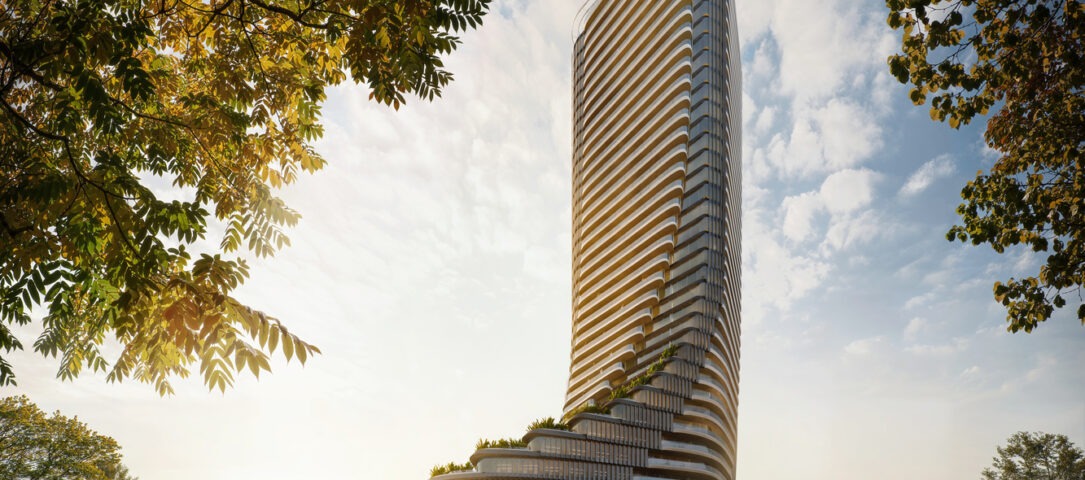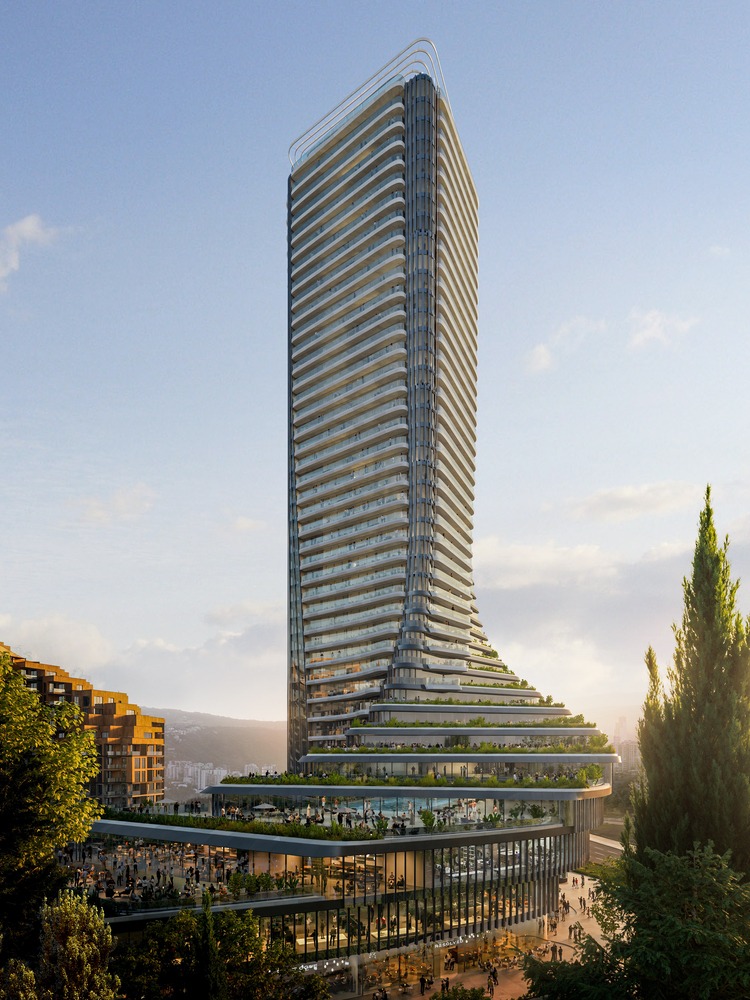
A Bold New Addition to Tbilisi’s Skyline
Tbilisi is undergoing a major transformation, and at the heart of this evolution stands Cityzen Tower, a groundbreaking new project by Zaha Hadid Architects. This 42-story high-rise is not just another addition to the city’s skyline — it’s a bold statement about the future of urban living in Georgia’s capital. Designed to integrate seamlessly with its surroundings, the tower combines cutting-edge architecture with sustainability and community-centered design.
As part of the Cityzen development, the tower is envisioned as a dynamic space that brings together residential, commercial, and public areas in one interconnected hub. It’s more than just a place to live or work; it’s a space that fosters interaction, social engagement, and a deeper connection with nature. With its cascading terraces and green integration, Cityzen Tower challenges the traditional concept of high-rise buildings by embracing openness, light, and fluidity.
Cityzen Tower isn’t just about height — it’s about redefining what a modern, sustainable city should look like.
What makes this project stand out is its commitment to sustainability and innovation. Unlike conventional skyscrapers that prioritize sheer height and density, Cityzen Tower introduces a fresh approach, balancing vertical living with ecological responsibility. Its design not only enhances Tbilisi’s architectural landscape but also sets a precedent for future developments in the region.
A Site Steeped in History, Ready for Transformation
The location of Cityzen Tower holds deep historical significance. Situated at the intersection of Mikheil Tamarashvili and University streets, this site was once home to the Soviet military headquarters for the Caucasus region. For decades, it stood as a reminder of Tbilisi’s past, marked by military presence and political shifts. Now, the area is undergoing a dramatic transformation, symbolizing the city’s progress and aspirations for the future.

Saburtalo, the district where the tower will rise, has seen rapid development in recent years. Traditionally known as an educational and residential hub, it is now evolving into one of Tbilisi’s most dynamic urban centers. New retail spaces, office buildings, and mixed-use developments are reshaping the neighborhood, making it a focal point for business and culture. The presence of universities and research institutions further enhances its appeal, attracting young professionals, students, and innovators.
From a Soviet military site to a futuristic urban hub — Cityzen Tower represents the changing face of Tbilisi.
Another key factor in the site’s transformation is its excellent connectivity. The area is well-served by Line 2 of the metro, ensuring easy access to other parts of the city. This accessibility, combined with new urban planning initiatives, is helping to redefine Saburtalo as a model for modern, pedestrian-friendly development. With Cityzen Tower at its core, the district is set to become a vibrant, interconnected space that reflects the ambitions of a growing metropolis.
Design Inspired by Tbilisi’s Natural Beauty
Cityzen Tower is not just a building; it’s an organic extension of Tbilisi’s unique landscape. Inspired by the rolling hills and winding river valleys that define the city’s geography, the tower’s architecture flows naturally, rather than imposing a rigid form onto the skyline. This fluidity creates a sense of movement, making the structure feel like a living, breathing part of the city rather than an isolated skyscraper.
One of the most striking features of the tower is its cascading terraces. At the base, these terraces form a seamless connection with the adjacent Central Park, offering green spaces for public gatherings, relaxation, and leisure. Unlike traditional high-rise developments that often feel disconnected from their surroundings, Cityzen Tower is designed to engage with the city at every level. Cafés, seating areas, and communal zones encourage interaction, transforming the base of the tower into a vibrant social space.
«Great architecture is not just about form, but about how people experience and interact with space.» — Zaha Hadid Architects.
As the tower rises, the terraces evolve into private balconies and shared spaces for residents and office tenants. These elevated green areas provide breathtaking panoramic views of Tbilisi while maintaining a close connection to nature. The design philosophy behind these terraces is to break away from the conventional «glass-and-steel» aesthetic and instead create a building that breathes, adapts, and responds to its environment.
Built for the Future: Sustainability at Its Core
In an era where sustainable design is no longer a luxury but a necessity, Cityzen Tower sets a new benchmark for environmentally responsible urban development. Designed to meet LEED Gold certification standards, the tower incorporates a range of eco-friendly features aimed at reducing its environmental footprint while enhancing the quality of life for its occupants.
One of the key sustainability strategies used in the design is natural ventilation. The tower’s structure allows for optimized airflow, reducing the need for artificial cooling and lowering energy consumption. Additionally, advanced solar shading techniques help regulate indoor temperatures, minimizing reliance on air conditioning and cutting down on carbon emissions.
Locally sourced materials play a crucial role in the tower’s construction, ensuring that the project aligns with Georgia’s architectural traditions while also reducing transportation-related environmental impact. The integration of rainwater collection systems further underscores the building’s commitment to sustainability, supporting irrigation for the green terraces without excessive water use. Drought-resistant vegetation is also incorporated, ensuring that the landscaping remains lush and vibrant with minimal maintenance.
Beyond its individual sustainability features, Cityzen Tower serves as a model for how high-rise developments can integrate with their urban environments in a responsible, eco-conscious manner. By prioritizing green spaces, energy efficiency, and sustainable materials, the project challenges outdated notions of skyscraper design and redefines what modern urban living can look like.
Cityzen Tower proves that a high-rise can be more than just a building—it can be a force for environmental and social good.
A New Landmark for Tbilisi’s Urban Growth
As Tbilisi continues to grow, the need for well-planned, sustainable urban developments becomes increasingly urgent. Cityzen Tower isn’t just about adding another high-rise to the skyline; it’s about shaping the future of the city in a way that balances innovation with livability.
The project is a testament to the evolving identity of Tbilisi—a city that values both its rich history and its forward-thinking ambitions. With its integration of residential, commercial, and public spaces, Cityzen Tower fosters a sense of community that goes beyond traditional skyscraper developments. It reflects a new era of urban planning, where connectivity, sustainability, and human-centric design take priority.
Cityzen Tower isn’t just shaping Tbilisi’s skyline — it’s shaping its future.
Developed by IG Development Georgia, the tower is scheduled for completion in 2028. As Zaha Hadid Architects' first project in Georgia, it marks the beginning of a new architectural dialogue between global design excellence and local cultural heritage. With its bold vision and innovative approach, Cityzen Tower is set to become a defining landmark in Tbilisi, demonstrating what’s possible when architecture and urbanism come together in harmony.

